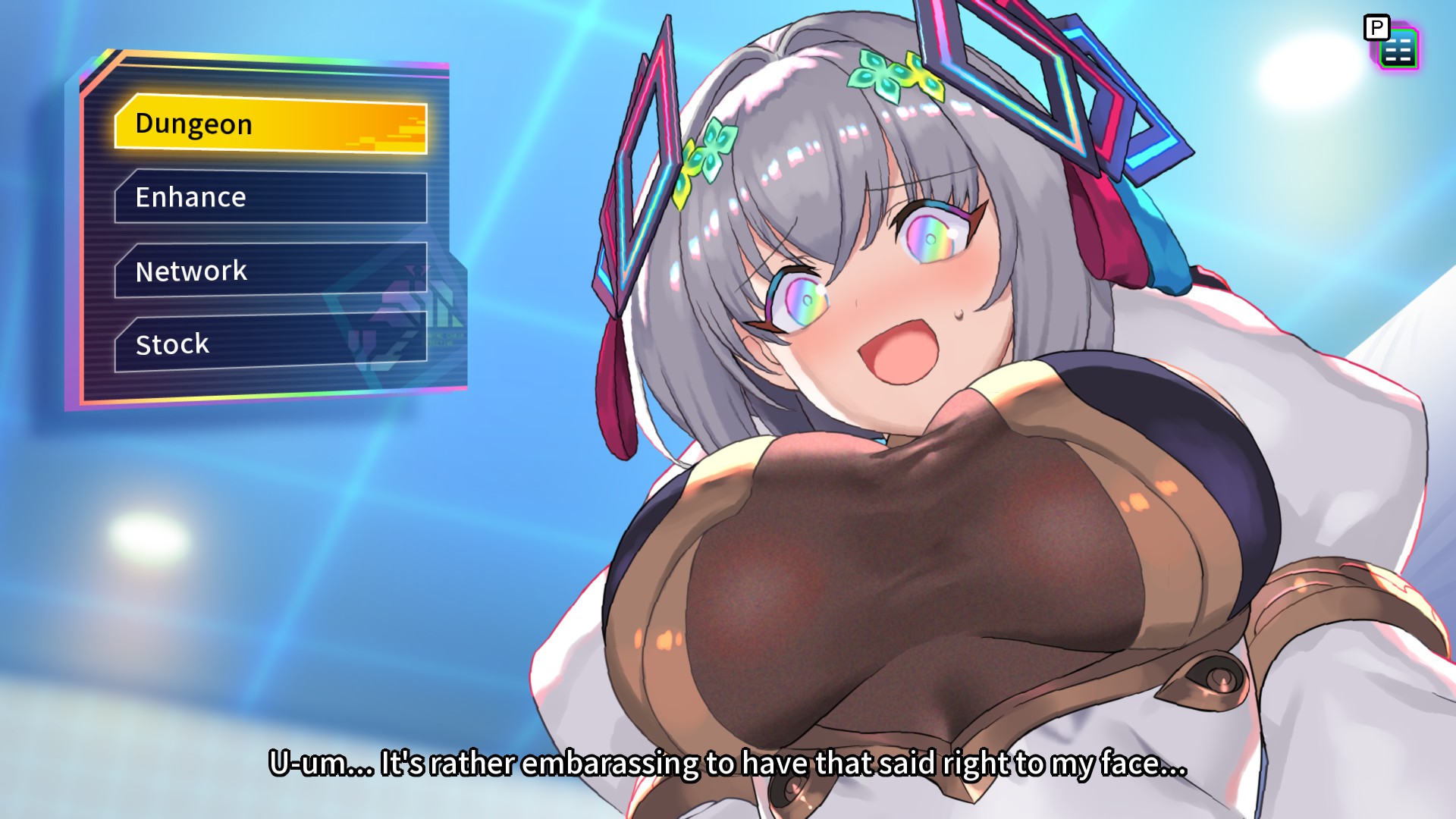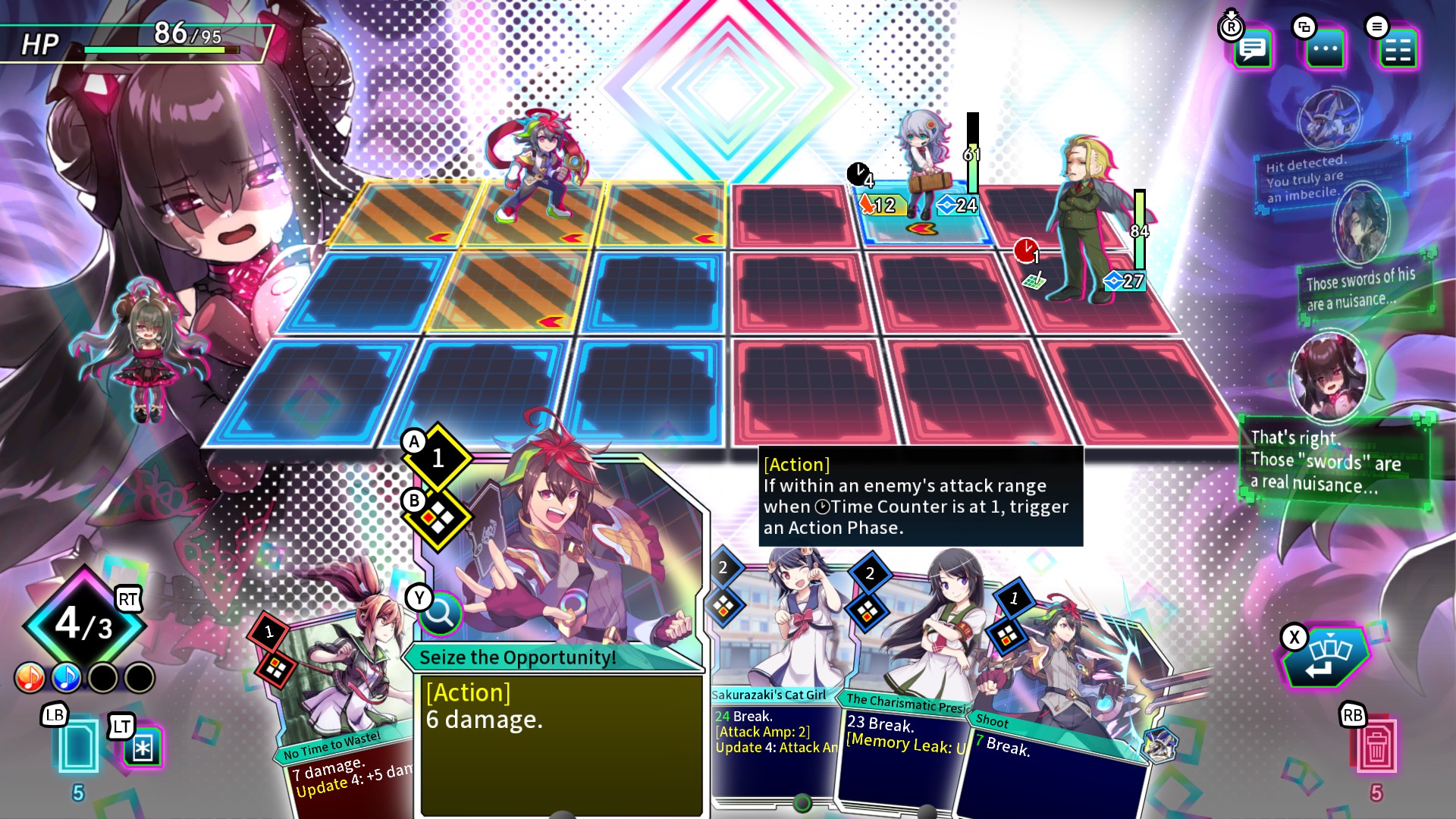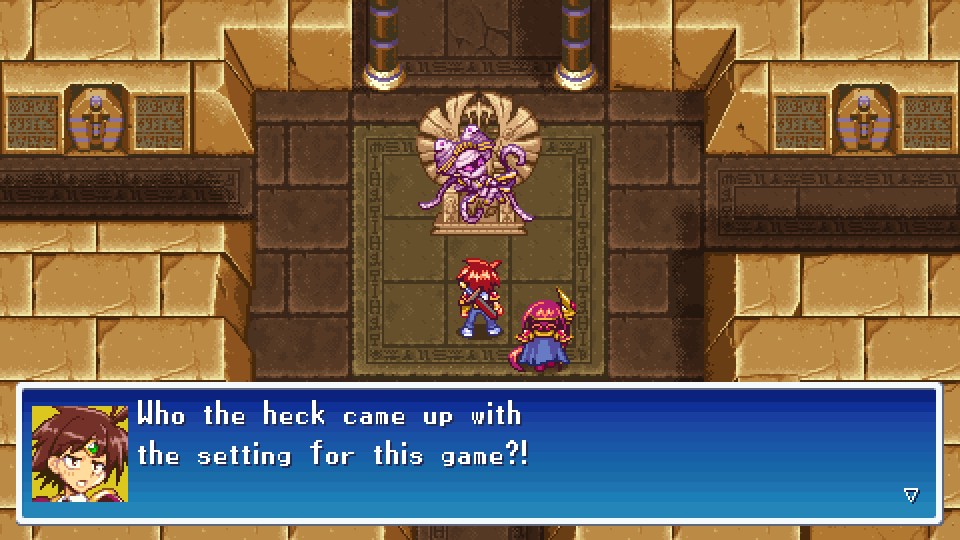
I have spent many years doubting Inti Creates but they seem to be out to prove me wrong as of late. Their most recent masterpiece is Card-en-Ciel, which combines several of their previous games, as well as several insane sounding fictional games, into a blender to create a roguelite styled card battler not unlike Monster Train or Slay the Spire mixed with, as is par for Inti Creates now, a truly ridiculous number of idol songs.
Allow me to make this review very quick for the cultured audience here: The boss of the second dungeon is a shy, nervous, 2 story tall schoolgirl mecha cheered on by her complete degenerate of a boyfriend who insists he will burn his love for giant women on you. Once you beat these two weirdos down, the mecha girl gives her boyfriend a lap pillow to help him recover and your female companion goes "Hmm..." upon seeing this. Upon reaching the main menu, you unlock a dedicated "Lap Pillow" button to receive a lap pillow from your companion at any time.
As you can see, this is one of the last truly innovative games of the modern era.
The structure of the game has you going into various dungeons that all look the same and doing the usual roguelite deckbuilding action: Fight people, get better cards, get an engine that can go nova, and beat down the boss. The biggest gimmick are the "Muses" which, in true Gunvolt style, are anime girls singing idol songs. Muses have a trigger criteria and, once you do, their song starts and they give you a passive ability that allows you to crank your decks engine. Eventually, you get to a point where you play two cards, and then three different muses all start singing their various songs. Cards themselves can be used for movement on your grid as well as played for their abilities. You are limited on cost for cards you can play, so using movement to dodge attacks, and thus having a few crappy cards, is definitely useful. The cards typically all support one of the main gimmicks of the game with only a few bridging gimmicks, and the gimmicks on offer are some of the most creative in the genre. Chaining 0 cost cards, chaining 3 cost cards (You only have 3 cost per turn so using multiples of 3 cost cards is a bit of a trick in and of itself), damaging yourself and preventing yourself from actually damaging yourself while reaping the benefits, playing cards while you have precisely 5 cards in hand, enhancing cards as you play, Gunvolt boss cards can all "Convert" from their human to septima forms and thus change their card effects when you trigger them, filling your deck with trash debuff cards and then consuming them to activate abilities on other cards. Each gimmick has a few corresponding muses that will enhance or facilitate combos, such as allowing the 5 cards in hand effect to always trigger or allowing self-damage to be blocked with error cards. The idol abilities are so decisive for these combos that the game decides each time you run prior to starting what gimmicks it is going to favor and tailors your card and muse offerings around those, so you lack some of the freedom of games like Monster Train, but there is still plenty of variety on offer that it remains fun to cobble your combos together all the same.
Each dungeon is "themed" around a game, but that only tends to effect which gimmicks are in the pool of what it can offer, the dialogue, and the bosses, who are all strangely well featured and thematically appropriate, with multiple phases and gimmicks. The games range from Inti Creates classics like Gunvolt, Galgun, or the more recent Divine Dynamo Flamefrit that was released with this game (Reviewed below) to some fictional titles like the aforementioned mecha girl dating sim and or one where the president is an anime girl (voiced by a certain otaku nerdy rapper female who might be familiar to you. For most of you who know, this will cause you a bit of distress but I cannot complain about her performance.), as well as a couple of games that are obviously the barely used assets of an abandoned project (The detective and cyberpunk games) that I hope Inti Creates can eventually make. The boss encounters of the story take place in gimmick maps where you have access to every single card you have ever pulled in a massive, thousand card deck, as well as every single Muse. This is precisely as stupid as it sounds and probably not the content you will most often engage with if you return after clearing the story. Each dungeon provides difficulties from Normal up to Hard+9 with a fairly sophisticated score system. You are scored on taking as few turns in all of your combats as possible; which means fighting as little as you can and always winning on the first turn if you can. You can, and must if you really wish to score well, stack the deck with this using the Wild Card feature which allows you a small side deck of cards you can pull one from each turn. Use of this can ensure you keep your wins on the first turn while you get the parts you need for your deck to go nova. The good news is that unlike many previous terrible Inti Creates ranking systems, this one does not get in the way of the game. A 1 star run where you struggled and took a bunch of extra fights to try to recover, or a 1 star run where you indulged in a power fantasy of building a stacked bloated deck, or a 2 star run you squeaked by clean with just your Monster Train skills are all still quite fun, as is a carefully stacked wild card aided run of quick wins.
There are a lot of roguelite card battlers out there, and Card-en-Ciel is unlikely to replace the elegance and depth of Monster Train. In fact, everything about it is over the top and inelegant, outside of its scoring system. And that is part of the charm. A big loud celebration of Inti Creates history mixed with an extremely creative card battling core. As a result, it is one of my favorite games of the year and one I keep going back to for a few more quick runs.


Divine Dynamo Flamefrit was released as a preorder bonus for Card-en-Ciel, and it really must be evaluated as such, and not as a standalone game. I will not devote too much time to this as it is an hour long game, but the aesthetic influence of it is quite clear: It is full of classic anime and video game callbacks that most readers simply will not be able to get not having grown up in Japan. The grand finale of the game is a reference to Goemon 4 on the SNES and there are certainly countless more references that I missed.
Flamefrit is comprised entirely of on foot dungeon exploration interspersed with giant robot boss fights that feel like Punchout if you had a flamethrower instead of an uppercut. The dungeon crawling is soporific and dreadful; entirely lifted from Blaster Master Zero, complete with BMZ2's absurd parry, and complete with BMZ2's fat slow pacing and constantly leading you into side rooms that only offer small ammo and health refills. The boss fights are far more fun, with creative and interesting patterns. There is not much else to say here given the game is just three dungeons and about as many boss fights. There is nothing to do once you beat it. You will clear it once and never think of it again. I would honestly say Mighty Gunvolt has more value than Flamefrit, but it is hard to argue with Flamefrit's aesthetics and nostalgia.